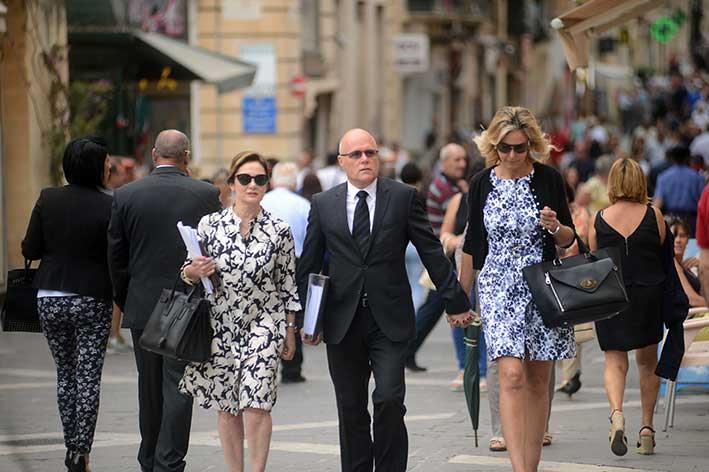The police and the Civil Protection Department never met with the head of security at Malta International Airport (MIA) to discuss risk or compile a risk assessment report for the 2015 PaqPaqli Ghall-Istrina event.
23 people were injured, some seriously, when a supercar careened into a crowd of spectators in October 2015 during the annual event to raise funds for the Malta Community Chest Fund, which falls under the responsibility of the Office of the President.
The Porsche 918 Spyder was being driven by British millionaire Paul Bailey.
Bailey, together with the organisational committee stands accused of involuntarily causing grievous bodily harm, as well causing damage to various motor vehicles, through imprudence, carelessness and non-observance of regulations.
Head of security at MIA Patrick Murgo told the court that he could not recall whether an insurance policy had been taken out by the organisational committee for the event, which was a requirement for the event to have taken place on MIA property. He confirmed it was up to the organisational committee to procure insurance, under the auspices of the President, however he has no recollection of whether insurance had been taken out and does not remember receiving a copy of the insurance policy.

Murgo also told the court how his meetings with the organisational committee for, police or CPD were limited to the safety and security of airport and passengers.
He also told the court how the crash-barriers used in the event were intended to avoid damage to any nearby aircraft and cordon off the operational runway at the MIA.
Two types of barriers were used, concrete ones to protect nearby aircraft and water-filled barriers to cordon off the public from restricted areas.
Police involvement together with MIA security was limited to patrolling the area to ensure that the public did not enter restricted zones, taking care of funds collected and as a precaution should any disturbance take place.
It emerged Murgo could not recall whether high-speed trials had been carried out prior to the event, despite an agreement to do so.
A legal point had been argued in court where it was confirmed that the activity site had temporarily stopped being a restricted area and became a public area. A legal notice to this effect had been issued. Defence lawyers harped on this point, presumably to highlight the role of the national authorities for the public’s safety.

“The legal notice says that a zone is set out and declared as an area where the public may enter without security restrictions”.
This meant, Murgo told the court, that the responsibility of the event therefore became limited to ensuring that MIA property was protected as the management of the temporarily public area does not remain the airport’s responsibility.
Lawyer Stefano Filletti questioned whether the event organisers discussed high-speed trials with the witness, in view of the supercar’s capabilities.
Murgo explained that the second runway had been conceded for the event in order to keep the public as far away as possible from the supercar. He also told the court how it was the organisational committee who chose water-filled bollards so that they could be quickly removed.
Murgo added that had MIA’s primary runway been compromised for an unrelated issue, it was up to him to ensure that the second runway being used for the event could be quickly cleared and used by the MIA itself.
He told Magistrate Bugeja that it was up to MIA to ensure the water-filled bollards were placed correctly, but that they had asked the committee to provide them and will them with water.

“The barriers were there to ensure the security of the airport. Concrete barriers were to protect a group of impounded aircraft and the water bollards for the area of aviation operations”, Margo told the court.
He added that the audience should have been at least 100m away from the high speed area.
The defendants of the case , aside from Paul Bailey, are TV presenter Tonio Darmanin, Angelo Mario Mannara - 51 from Birzebbugia, Christopher Sultana - 41 from Lija, David Bugeja - 38 from San Gwann, Brian Gatt - 44 from Naxxar, Jonathan Tonna - 40 from Naxxar, Kevin Perry - 44 from Qormi , Melvin Haber - 44 from Naxxar, Ian Keith Cilia Pisani - 38 from Mgarr, Jonathan Bruno - 41 from Mosta, Tonio Cini - 47 from Naxxar and Agostino De Giorgio - 52 from Sliema. The 12 men all form part of the organisational committee.
A magisterial inquiry launched after the incident had found that the accident was caused by Bailey when he lost control of the vehicle. Mechanical failure was ruled out. The inquiry also pointed its finger towards the organizational committee, insisting that the security measures in place were not enough in the circumstances. Therefore, the committee, which fell under the office of the President, would have to shoulder responsibility on 'secondary causes'. The magisterial inquiry had exonerated President Marie Louise Coleiro Preca, who was not involved in the organisation